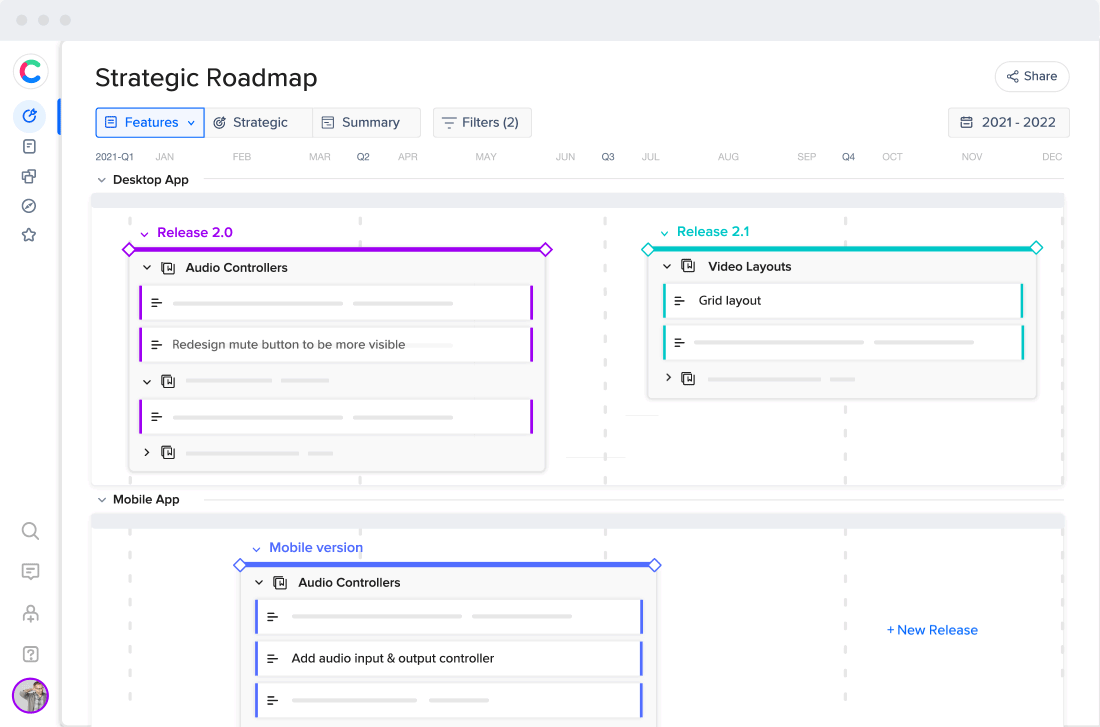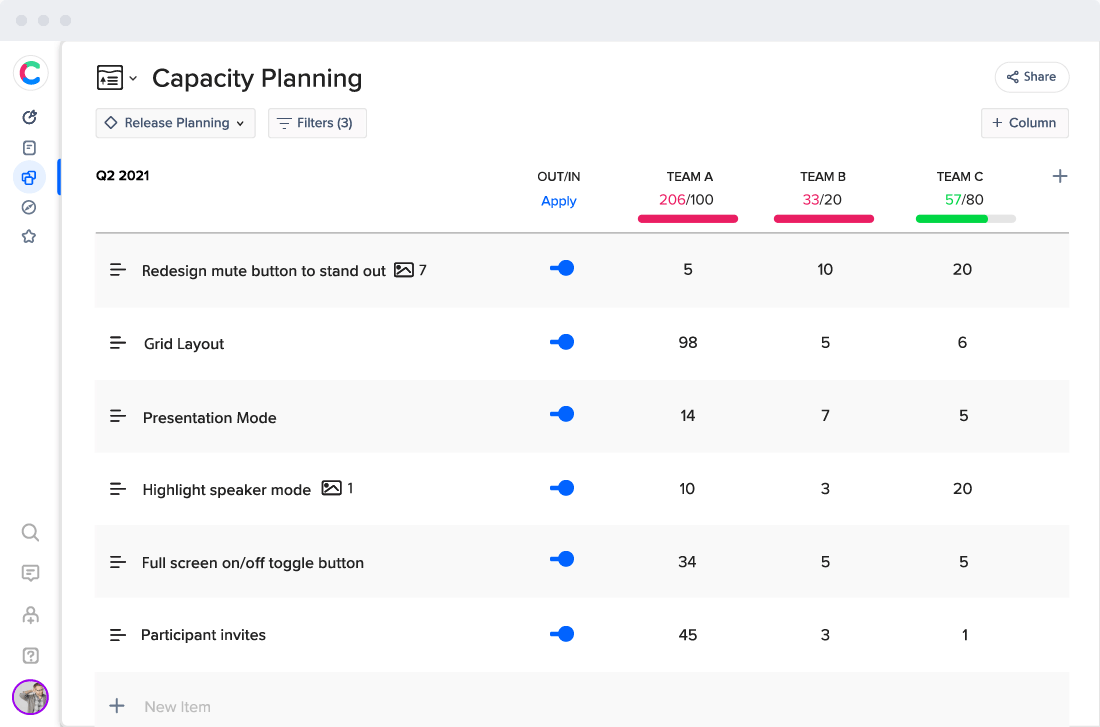What is product management?
You can think of product management in two ways:
- The role or work of a single Product Manager (or several/of each, if the company has more than one).
- A catchall term to describe a company’s entire product department, which itself can include:
- Product Leader (for example, the Chief Product Officer or VP of Product – enterprises with sophisticated product organizations often have a CPO who manages multiple VPs)
- Product Manager
- Product Owner
- Product Operations (“Ops”) Manager
- Product Operations (“Ops”) Analyst
What are the main tasks of product management?
Whether a company’s product management function consists of a single Product Manager or a larger team, the function is typically responsible for the following:
- Researching the market.
- Learning about the company’s target buyers and users.
- Prioritizing what to build.
- Connecting product strategy to business objectives.
- Communicating these strategies and goals to stakeholders across the company (articulating the “why”).
- Generating and maintaining enthusiasm among key contributors to the product.
- Aligning the entire organization around an agreed-upon strategic plan.
- Coordinating and overseeing the product’s development.
- Working with sales, marketing, customer success, and other teams on their respective contributions to the product’s launch and its eventual market lifecycle.
What does a Product Manager do?
Why is product management important?
Developers build products. Marketing professionals create compelling messages touting the value of those products and place those messages in front of potential buyers. Salespeople sell the products.
But none of those teams are responsible for deciding what products to create in the first place, which functionality to prioritize, or which persona or industry to target first. Those strategic decisions are at least as important as building, marketing, and selling the product. After all, unless the company makes the correct strategic decisions upfront about what to build, which segments of the market are most likely to buy, and how to determine what success looks like, functions like marketing and selling are less likely to succeed.
This is why product management is so important. Product management serves as the strategic voice of the company, the market, the customer, and the product itself. The Product Manager or team is always looking for strategic opportunities to build, enhance, and release products and functionality that will resonate with a particular market segment for a particular strategic reason.
You can even think of product management as the strategic glue that keeps stakeholders across a company connected around a shared vision, plan, and set of goals for the product they’re all helping to bring to market.
What are the product management processes?
Unless we’re talking about a brand-new startup, the chances are a company will have multiple products at various lifecycle stages. Some products will have been on the market for years and in the mature (or decline) stage, others will be new to the market and in the growth stage, and the company will probably have still other products in development.
The product management department will be responsible for the success of all these products. That includes offering strategic support to keep the mature products continuing to earn revenue as long as possible, analyzing market feedback on the newer products and offering the right strategic enhancements to extend their growth phase, and coordinating with stakeholders to bring about a successful launch for the products in development.
But in this guide, we’ll focus on the product management process for conceiving and launching a wholly new product. There are many methodologies to help guide Product Managers from concept through release, but we’ll summarize the seven-step product management process from Hotjar.
The seven-step product management process
Step 1: Identify a problem worth solving
As the Hotjar team points out, the product management process will typically start by identifying a pain point or void in the market — a real challenge to a real market segment, and a problem serious enough that your target buyer would be willing to pay to resolve it.
You can find these market problems worth solving in several places:
- Collecting feedback from your existing customers.
- Talking with prospects.
- Asking your sales reps about common objections they’re hearing — such as functionality prospects say they wish you offered.
- Asking your customer success agents about common complaints they receive from customers. (Perhaps there’s a new product idea in these calls lamenting the lack of specific functionality.)
- Monitoring social media or online forums where your target personas gather and listening to what they discuss and complain about.
Step 2: Investigate the solution’s business viability
Before devoting any resources to building the product, you’ll need to do some basic business research. That means answering questions such as:
- Is the potential market opportunity big enough to justify the investment in development, marketing, etc.?
- Is this a solution our persona would pay for?
- Do any of our competitors already offer a comparable solution?
Step 3: Test product models
Let’s say you’ve answered the questions above and determined that, yes, your idea for a solution is viable, represents a sizeable revenue opportunity, and doesn’t have a real competitor.
Now it’s time to think through the various ways you might build the actual product. What will it look like? How much functionality will you want to include in the first version? How can you build a user experience that will resonate with your market?
This is the stage where your team will sketch out several possible product models, interfaces, and levels of functionality — and then, ideally, run them by a group of potential users to learn what they think of the various options.
Step 4: Nail down your strategic plan and goals
At this point, your team has settled on a clear winner in terms of the product’s layout, UX, and feature set. Now you’ll want to translate your vision into a strategic plan, with clear business objectives tied to every aspect of that plan.
At this stage, says the Hotjar team, it’s time to create a product roadmap that communicates both the functionality you plan to build and the objectives and key results you’ll be monitoring to gauge your product’s success.
Note: Because your strategic plan will likely change several times between this early conceptual stage and your product’s eventual market release, you’ll want to use a flexible, purpose-built roadmapping tool, like the one shown below from craft.io.

Step 5: Build alignment and enthusiasm across your company
One key trait of product management that we haven’t discussed yet in this guide is the fact that the role requires help and cooperation from stakeholders throughout the organization: sales, executives, marketing, and of course development.
At this stage of the product management process, you’ve done the legwork and developed a compelling, data-supported case for moving forward with your new product idea. But to pull this off, you’ll need to enlist the support of teams throughout your company.
Fortunately, you’ve got your story, your research (user feedback, surveys, personas’ responses to your prototypes or wireframes, etc.), and now your product roadmap to make that case.
So begin sharing your plan with stakeholders — one group at a time, ideally, to avoid cross-functional conflicts — and building that internal support for help and resources to execute on your product strategy.
3 No-Bull$%&t Tips to Help Product Managers Improve Their Persuasion Skills
Step 6: Build an MVP
Here you’ll take the agile development approach and build a minimum viable product: a solution with just enough functionality to help your persona solve the problem you determined — and they helped you validate — was worth paying for to solve.
Once you’ve released your MVP to users, you’ll begin soliciting their feedback and monitoring their usage to learn what’s working with the product and where your team can improve it.
Step 7: Drive the iterative process of continuous improvement
Now you’re ready to begin the ongoing process of working with your various stakeholder teams to continually improve and enhance the product. Initially, you’ll take the first round of feedback and analytics you’ve gleaned from the market’s response to your MVP — and work with your development team to improve the product accordingly.
At some point in this iterative process, you’ll have expanded your MVP into a more full-featured solution, and you’ll be ready to oversee a formal launch to the broader market. When you reach that stage, you’ll shift your focus to positioning the product for release (coordinating with marketing, sales, and customer success).
What are the main areas of product management?
Another way to understand the product management role is by breaking the many strategic responsibilities into three main categories. As you’ll see, these areas map nicely to the steps above.
Product discovery
Product discovery refers to the processes that help product management professionals determine what to build.
You can think of this phase as covering the first two or three steps in the seven-step process above. Identifying a problem worth solving, researching the business viability of solving it for a given market, and weighing the various possible ways to turn that solution into a product — all of these strategic steps fall under the product discovery phase.
The key assets involved in the product discovery phase might include:
- User surveys and other types of feedback.
- A total addressable market (TAM) study or another type of research to determine the size of the opportunity.
- Mockups, wireframes, or other representations of potential models for the product.
Product planning
Product planning maps closely to steps four and five above: nailing down a product strategy and objectives, and then sharing the plan with stakeholders to build buy-in and momentum for the initiative.
The key assets involved in the product planning phase might include:
- Your strategic product roadmap.
- A list of KPIs, OKRs, or other quantifiable success metrics — ideally, at least one objective for every strategic component of the work proposed on your roadmap.
Product development
Product development represents the stage at which the organization shifts from deciding to doing. This stage maps to steps six (build the MVP) and seven (iterate and improve) above.
Here, you will be working closely with many teams across your organization to bring your product concept to reality — first as a minimum viable product that will help you quickly gauge market interest and generate early feedback, and later as a full-featured product complete with a broader market launch.
The key assets involved in the product development phase might include:
- Your MVP.
- Your marketing, sales, and other materials to help support the product’s release and eventual market success.
- Your product backlog.
What skills do you need for product management?
Because product management can mean either the role of an individual Product Manager or the collective responsibilities of an entire product team, the skillset this function covers is enormous. So we’ll narrow our focus to the key skills that make a great Product Manager.
Strategic vision
Product management is first and foremost a strategic function. As a Product Manager, you won’t need to know the technical details of how to build your product, or how to break the big assignments into actionable tasks for your company’s developers, designers, and QA testers. Those are tactical responsibilities that will typically fall to product owners, project managers, and Scrum masters (if you’re an agile organization).
But you will need to know how to identify market problems, conceive potential solutions, validate those ideas with real-world potential buyers, and pull all of that together to create a viable strategic vision and share it with the right people in your organization.
Communication skills
Another key to successful product management is the ability to communicate your plans, goals, and needs to various stakeholders across your organization (and even directly to your potential customers).
Remember: Product Managers rarely have any organizational authority over the people and teams whose help they’ll need to bring their products to market successfully. Developers, designers, UX professionals, marketing teams, sales reps, and customer success agents — all report to people other than the Product Manager. That means you’ll need to have strong communication skills to clearly articulate to your colleagues what you need, and why helping you make it happen will ultimately benefit the company.
Analytical skills
Yet another must-have product management skill is the ability to conduct research, compile data, and turn the raw numbers into useful business insights.
You’ll need to know, for example, how to read the usage data in your products to learn where your users are spending their time, what functionality they’re ignoring, and what those stories tell you strategically about whether your ideas for the product value line up with reality.
Technical knowledge
We don’t believe you need to come from a technical background or hold a degree in engineering or computer science to be an effective Product Manager — even if you’re in the product management department of a technology company.
But you will need some basic technical knowledge to succeed in a product management role. Why? Because a major aspect of your work will involve capacity planning, understanding what resources your developers will need to accomplish a given project, and having a sense of how much time various assignments should take them to complete.

If you lack the basic technical understanding to know these things before you sit down with your development team, you won’t be able to properly assess your company’s resource levels or your ability to complete projects in a given timeframe.
Note: Having technical understanding can also help you earn the trust of your developers and build stronger relationships with that team. So even if you don’t view yourself as a technical person, it’s a good idea to invest time in learning about the technical field that your developers work in every day — whether that’s learning about hardware, software, operating systems, or other tools they use to do their work. Learn to speak their language, and you’ll find your developers treating you more like a true partner, because you’ve taken the time to learn about their world.
For a deeper dive into the specific skillset needed for success in product management, we recommend the Product HQ article “Essential Product Manager Skills.” It goes into tremendous detail and includes traits such as delegation skills, interpersonal abilities, and even empathy.
Do you need to take a product management course?
The short answer is no. Organizations posting product management job descriptions rarely require (or even ask for) completed courses or certificates in product management.
But that’s not to say a product management course would be a waste of your time. In fact, we believe that if you can find the time, you’ll want to supplement your on-the-job learning with professionally taught product management courses.
The product management profession changes often, absorbing new best practices, tools, and processes — and you’ll often find that the best of these courses have incorporated these learnings and best practices into their curriculum. Having said that, here are a few respected courses and degree programs, which we’ve listed in order of time commitment required, from longest to shortest.
Institute of Product Leadership
(18 months, weekends only)
Become a Product Management Leader
Product School
(8 weeks, remote learning)
Reforge
(4 or 6 weeks, part-time, remote learning)
Note: This course requires Reforge membership, but the organization offers many benefits for PMs who join.
280 Group
(4 days, online and instructor-led)































